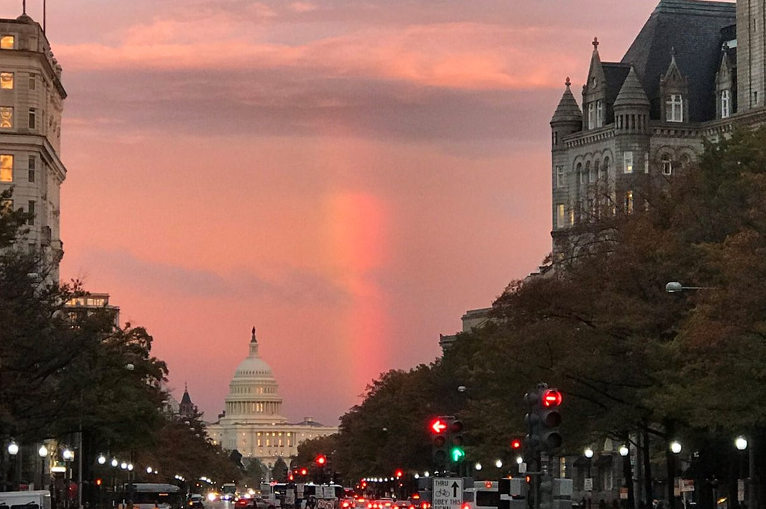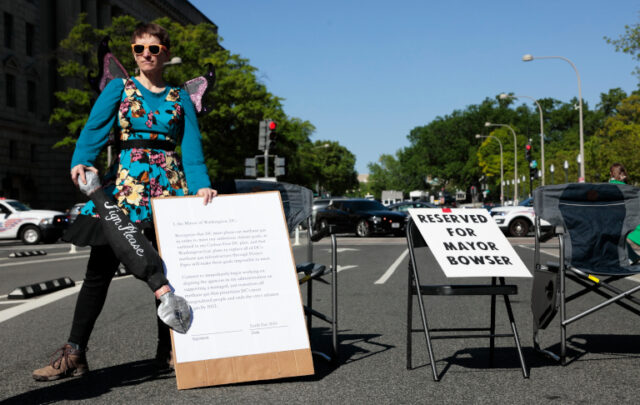(This is the second in a series on the impact of the 2018 midterm election on federal climate policies leading up to the 2020 presidential election. The first installment may be found on Resilience.org here.)
Dateline November 14, 2018
The most contentious and expensive midterm election in US history is almost over. When the dust finally settles it will have ended pretty much as predicted. The incoming 116th Congress will open for business— divided. Democrats will control the House Republicans the Senate. It is a fitting reflection of the state of the union.
The election results are such that progressives and populists are each spinning them to advantage—with varying degrees of success. Within hours of the polls closing, Trump began a victory lap evaluating his efforts as history-defying. For a change, there is some truth in what The Donald is saying. It was just the third time the party in the White House gained Senate seats in a midterm election. The last time was 1914—Wilson was president. That same year the Democrats lost 61 House seats—a far more significant loss than #Trumplicans have just experienced.
Typical of the nation’s Narcissist-in-Chief Trump congratulated the winners for having embraced him. A day after the election he taunted the losers who refused to wrap their arms around His Greatness and what he represents. To Mike Coffman (R-CO) Trump merely said “too bad Mike.” The Grand Wizard of the White House was sharper in his shout-about to Representative Mia Love (R-UT)—the only Republican woman of color serving in the current Congress. “Mia Love gave me no love. And she lost. Too bad. Sorry about that Mia.
The Democrats did their own bit of crowing. The current Minority Leader and likely next Speaker, Nancy Pelosi, alluded to the results as the dawning of a new day for America. Judging from the row between Trump and a CNN reporter, the forced resignation of Attorney General Sessions, and appointment of an Acting Attorney General that many believe uniquely unqualified, it is just another day in America in which Trump doubles down on being Trump.
How the environment fared in the midterms, like most things these days, is up for debate. Much depends on one’s perch and expectations. Although pleased with the Democratic takeover of the House, most reactions from the climate defense sector were subdued in tone but suggested there might be better days ahead in Capital City. I have my doubts.
The League of Conservation Voters’ (LCV) Senior VP, Tiernan Sittenfeld, described the election outcome this way:
Tonight, voters across the country decisively rejected the most anti-environmental U.S. House of Representatives in our nation’s history…voters have clearly called for change, supporting candidates who campaigned on protecting people and our environment — and rejecting those who gave only lip service to the urgent threat of climate change. (emphasis added)
Mark Reynolds, executive director of the Citizens Climate Lobby (CCL), expressed his belief that under Democratic control there is untapped potential to advance bipartisan legislation to enact a national carbon tax. CCL is also the group most responsible for working with members of Congress to establish the bi-partisan Climate Solutions Caucus.
The Lobby is allied in its efforts with the Climate Leadership Council—a group of high level moderate and old school conservative (Reagan/Bush) Republicans like James Baker and George Shultz and other individual and corporate founding members including Ben Bernanke, Janet Yellen and Christine Todd Whitman, as well as Corporate Members AECOM, Allianz, AT&T, Exelon, First Solar, and MetLife.
Rhea Suh, president of the Natural Resources Defense Council Action Fund, said the election results gave the House a mandate to hold the Trump administration accountable. Others like Tom Steyer, the founder and President of NextGen America and Brett Hartl of the Center for Biological Diversity agreed with Suh. Moreover, Hartl thinks the future holds little hope for sweeping climate change legislation because it doesn’t have a path forward. That’s a lot of resources and political capital to spend on failure. (emphasis added)
May Boeve, Executive Director of 350.0rg, spoke of the historic wins for women of color, and unprecedented youth turnout that would bring bold and powerful voices into our legislative process. Boeve singled out Alexandria Ocasio-Cortez, Deb Haaland, and Ilhan Omar who, with Antonio Delgado, have called for a Green New Deal—a program to rapidly move the nation off fossil fuels and entirely onto renewables. The concept resembles Bill McKibben’s call for a national mobilization like the one required to win WWII. McKibben is a co-founder of 350.org.
An overview is in order before offering my take on what the new Senate and House will mean for national climate policies going forward. Note I have highlighted some of the election results in the states. How voters responded to the various proposed climate-related measures will not go unnoticed by members of Congress and the Administration and will surely be referenced by climate defenders and deniers alike in support of their positions.
116th Congress
US House of Representatives
- Democrats will outnumber Republicans by at least 227 to 198[i]. Two hundred eighteen votes constitute a majority. There are still 10 House races to be decided several of which lean Democratic.
- Key committees will be under Democratic control. The committees include government oversight, energy, science, natural resources, science/technology, and budget, appropriations, infrastructure, agriculture, and workforce.
- At least eight newly elected House members have a science background.
- 16 of the 45 GOP members of the Climate Solutions Caucus[ii] lost their races, including its co-founder Representative Carlos Curbelo (R-FL).
- Minority Leader Pelosi has promised to make climate change one of the House’s priority issues should she become Speaker. She’s indicated her intention to resurrect the select committee on climate change that fell victim to the Republicans when they captured 63 House seats halfway through President Obama’s first term.
- Democrats have indicated areas of possible bi-partisan cooperation including energy efficiency, carbon capture, adaptation/resilience to protect communities from rising sea levels and disaster flooding, and infrastructure.
US Senate
- Republicans maintain their control. The final count looks to be 53[iii] Republicans, 45 Democrats, and 2 Independents (Sanders [VT] and King [ME]) who caucus and generally vote with the Democrats.
- The addition of one to two members to the Republican majority reduces the need for the Vice President’s vote in case of a tie. The defection of Senators Collins and Murkowski on some issues, e.g., healthcare, also becomes less problematic.
- On the Democratic side of the ledger, there are at least three conservative (Blue Dog) Democrats who will at times vote with the Republicans. The Senators are Manchin (WV), Kramer (ND), and Jones (AL). The times at which they may vote Republican involve judicial and executive agency nominees, e.g., EPA, Interior, and Justice,
- Republican senatorial candidates supporting fossil fuels, e.g., Kevin Kramer (ND), or anti-environmental regulation, e.g., “Red Tide” Rick Scott[iv] (FL) fared well.
Selected state results
- At least ten gubernatorial candidates who supported their state’s switching from fossil fuels to renewables were elected. In seven of the ten states, Democrats defeated Republicans; they included Illinois, Kansas, Michigan, New Mexico, Nevada, Maine, and Wisconsin.
- Anti-fracking ballot initiatives in Colorado, California were rejected by voters.
- Voters in Arizona defeated a measure to amend the state’s constitution to require 50 percent of the electricity in the state to come from renewables by 2030.
- Nevada approved a measure to require half of the electricity in the state to come from renewables by 2030. Because the measure amends the state’s Constitution, voters are required to approve it again in 2020 before it comes into force.
- Washington state voters rejected carbon pricing for the second time.
Battle lines are being drawn
Make no mistake whatever happens from this day forward, everything in Congress is going to be about the 2020 elections. In thought word and deed the opposing forces are readying themselves to continue the culture war on a grander scale than 2016 or 2018.
Trump set the tone and the stage for the 2020 election battles at his first press conference following the midterm. In addition to taunting Republican candidates who failed to embrace him, he deliberately picked a fight with a CNN reporter who asked a question Trump didn’t want to answer. The CNN reporter’s White House press pass was later suspended by Sarah Sanders who also released a doctored video as evidence of the reporter entering into a grabfest for the microphone with a female intern.
Trump has dialed his belligerent behavior towards the press up at least a notch. He accused a black reporter of being racist when she asked a question about the connection between the terms “nationalist” and “racist” and others of being stupid, losers, and worse. The only journalists he seems unwilling to insult are those from the FOX—Feed Our Xenophobia—network.
Although speaking to reporters for an hour and a half the day after the elections, Trump never bothered to mention that General Kelly, his Chief of Staff, had fired Attorney General Sessions. In a whirlwind of events Sessions was told to leave the building and his chief of staff, Mathew Whitaker was named acting attorney general. An appointment which has been called unconstitutional by Republican and Democratic legal experts including George Conway.
Two days after the election Trump was confronted by a pair of judicial opinions against his administration. A Ninth Circuit federal judge halted construction of the Keystone XL pipeline pending an environmental impact statement. Trump called the decision “disgraceful” and accused the judge of making a political decision. On the heels of that decision, the Circuit Court of Appeals confirmed a lower court’s blocking Trump from ending the Deferred Action for Childhood Arrivals (DACA)—the Obama-era program preventing the deportation of children brought to the US.
In response to the decisions, Trump raised his need to fill the six remaining vacancies and the possibility of breaking the Circuit into at least two pieces giving him an opportunity to pack the court with Republican nominees.
Climate advocates should be familiar with the role the Ninth Circuit’s Court of Appeals has played in combating climate change. In Alaska Oil and Gas Assn. v. Jewell, for example, the Ninth Circuit Court of Appeals upheld the government’s polar bear habitat designation as neither arbitrary, capricious nor in contravention of applicable Endangered Species Act (ESA) provisions. It is also the Circuit in which Juliana v US has been brought. If successful, the case would make a habitable environment a constitutional right.
It is fair to ask what does any of this has to do with the midterm elections and federal energy and climate policies? Bear with me for a few more paragraphs; I promise to tie it all together.
The evening of the elections Senator Lindsey Graham (R-SC) tweeted “When the GOP maintains control of the Senate, the conservative judicial train is going to keep running!” By “keep running” Lindsay was referring to the two Supreme Court justices, 29 circuit court of appeals judges, and 53 district court jurists that Trump has already appointed—an actual record Trump can claim without resorting to lies.
The division between the parties has only deepened in the nearly two years Trump has been in office. Republican winners in the Congressional elections were for the most part Trumplicans.Moderates like Curbelo not only lost their offices they were spat on by the President on their way out the door. When combined with the unwillingness of Senate Leaders like McConnell (R-KY), Grassley (R-IA), and Graham (R-SC) who now are not only going along with Trump but defending him in the press the possibility of compromise becomes a pipe-dream.
These senators were all at one-time establishment conservatives. The very group Trump and Bannon set out to replace. Although some have lost their seats, others like Graham and McConnell have been radicalized. Alternatively, perhaps, they’ve been infected with a strain of the Stockholm syndrome.
Elections of Republican leadership positions in the Senate will be held within days. Two senators likely to move into leadership positions are Thune (R-SD) and Barrasso (R-WY). It is not surprising that neither of these men is known to support federal regulation of the environment or believe in climate change.
Thune is now chairman of the Senate Republican Conference as well as of the Commerce, Science, and Transportation Committee. He is a long-time supporter of the Keystone XL pipeline. The League of Conservation Voters (LCV) gives him a lifetime score of 10 percent based on his voting record on major environmental legislation and confirmation of Trump’s judicial and agency nominees. As Senate Whip, Thune will play an even more prominent role in messaging and policy.
Senator Barrasso is chairman of the Senate Environment and Public Works Committee. He is the author of legislation that would significantly weaken the Endangered Species Act. LCV gives him a lifetime environmental score of 0-percent. On his becoming chairman of the Committee LCV’s Tiernan said:
It’s outrageous that once again a climate denier will lead a committee that could not be more critical to combating this global crisis and protecting our environment. Like current Chairman Jim Inhofe, Senator John Barrasso has consistently sought to prevent action to address climate change, has led the charge to block protection for drinking water for 1 in 3 Americans, and has said the role that human activity plays in climate change ‘is not known. (emphasis added)
Both Thune and Barrasso have consistently shown themselves loyal Trumplicans and are unlikely to act independently of the White House. Other successors to the Caucus’ leadership as well as crucial committee slots will be as in sync with Trump as Thune, Barrasso, McConnell, Graham, and Grassley.
Democrats will have even less say in what the Senate does in the new Congress than they have had in the current one. What they will have is an abundance of candidates running for the Party’s 2020 presidential nomination—so much of what will be said about climate change and the environment will be said in stump speeches and interviews rather than on the floor or in committee.
The Democrat’s battle between center and left-wing members is likely to be fiercer after the midterms. In much the same way Republican voters rewarded the Party’s populists; Democratic voters showed a preference for progressives.
With eyes on 2020 and a lack of real power, Minority Leader Schumer is going to have a much tougher time keeping Senate Democrats focused on a centrist message than his House counterparts—which is saying a lot. Schumer has consistently tried to plot a centrist course and appears strongly to believe that the best chance for keeping core supporters energized AND independents and moderate Republicans leaning Democratic is to focus on bread and butter issues like healthcare, drug prices, education, gun control. Senate Democrats not running for the presidency are likely to follow the lead of the new majority in the House on matters of climate and the environment.
Democrats are hardly in a better position to capture the Senate in 2020 than they were this year. On the surface, the election map looks better for the Democrats than the Republicans. The Democrats will be defending 12 seats and the Republicans 21. Many of these races, however, are not going to be competitive. Likely battleground states are Colorado, Georgia, Maine, and North Carolina.
Put yourself in the shoes of Schumer for a moment and consider the election results from Colorado. Two Democrats and three Republicans were just elected to the House. The districts of the Democrats are roughly the cities and suburban surrounds of Boulder and Denver,while those of the Republicans are the more rural areas of the state.
The State’s two senators—neither of whom w as up for re-election– are Gardner (R) and Bennet (D). Gardner has a 0 percent LCV rating, while Bennett’s is 84. The ratings for the five House members follow suit. The Democrats have very high scores and the Republicans very low.
Colorado also had a ballot initiative that proposed to ban new oil and gas drilling within 2,500 feet of homes, schools, and “vulnerable areas” such as playgrounds. The measure lost. It was, of course, opposed by oil and gas interests. It was also opposed by both the current and future governors—Hickenlooper and Polis respectively.
Opposition to the initiative was one of the few things the Democrat Polis and his Republican opponent for governor could actually agree on. Polis, as a Colorado Congressman, earned a score of 100 percent by LCV.
According to Josh Siegel, writing for the Washington Examiner, nationally-minded progressives, such as Sen. Bernie Sanders, I-Vt., and Al Gore backed the measure, viewing the potential impact of its success in broader terms. The Democratic Party of Colorado also endorsed it. Still, the initiative lost by a vote of 58 percent to 42 percent.
The Colorado vote on representatives, governors, and initiatives reflects divisions in other states. Voters in Washington state voted down for the second time a ballot measure that would have put a price on carbon. Arizona defeated a constitutional amendment that would have required 50 percent of the electricity in the state to come from renewables by 2030.
Many in the environmental community are blaming lost ballot initiatives on the tens of millions of dollars that opposing fossil fuel and utility interests poured into the campaigns. In Washington state $31 million oil company and Koch Industries dollars were put to work in opposition to the proposed carbon fee–nearly twice what supporters like Bill Gates and Michael Bloomberg contributed. The proposed fee was endorsed by 600 organizations and businesses and was estimated to be revenue positive pumping in an estimated $1 billion in non-climate destroying investments. Still, it lost.
Some are accusing the oil industry of having bought the election. Is that a fair or even useful conclusion? Fifty-six percent of voters opposed the initiative, with most saying the potential cost outweighed their desire to use the fee to combat global warming. It is the same reason cited by many Colorado voters and those in Arizona. The geographic distribution of the votes on the initiatives bear a striking resemblance to the votes for Democrats and Republicans in general—urban/suburban vs. rural.
The midterms show a pulling to the right and the left of the Republican and Democratic parties. The pull to the right seems to be having a solidifying effect on Republicans while pointing to divisions among Democrats.
Schumer’s effort to moderate the Democrats agenda in the Senate is driven by a hoped-for appeal to Southern and Mid-Western/Western voters whom he sees as being cast aside by Trumplicans. At the same time, it appears that the current number of presidential hopefuls serving in the Senate and the new class of incoming freshman representatives believe the winning ticket is to fight the fire of populism with an intense progressive back-fire.
The assumption seems to rest on voters having a binary choice between Democratic and Republican candidates. Although voters may have only two choices when they are in the voting booth, there is always the option of not voting at all.
According to some reports, Democrats are gaining confidence in their election results—specifically that candidates from the party’s left flank will be the most successful in 2020. The split between establishment and “social” Democrats raises the question of whether the days of the Blue Dog Democrat are numbered and what this might mean to the climate debate.
Schumer and his leadership team have many fewer opportunities to drive the conversation. Majority Leader McConnell has almost no reason to seek a balanced debate on environmental and climate policy. McConnell will keep the White House happy by following its lead and confirming its judicial and executive nominees.
The bottom line–
Over the next 12 to 24 months the House Democrats will drive the Congressional debate on climate.
Look for the next installment of the series in which I will be discussing what might be expected from a Democratically controlled House of Representatives. The in-coming class of freshman representatives portends a generational shift in the Democratic Party. A shift that places a much higher priority on combating climate change. Can the growing numbers of left-leaning progressives put in place aggressive climate policies that go beyond what is politically feasible to what is required to keep global temperatures below the 1.5 to 2 degrees Celsius threshold? Click in a few days to find out.
***********************************************
[i] As of the date of this article
[ii] The Caucus has accomplished little in the way of legislation. A number of environmental groups view the Caucus as a way for deniers to greenwash their positions. CCL values the Caucus as a bi-partisan forum at least willing to discuss the causes and cures of global warming.
[iii] The 53 would include Rick Scott (FL). Although a recount of the ballots in Florida is underway most experts are predicting that Scott’s lead over incumbent Senator Nelson (D) is unlikely to change.
[iv] Win or lose Scott, who is recognized as a climate science denier, garnered substantial support even though the environment was a prominent issue in the Florida races, e.g., algae blooms, off-shore drilling and rising sea levels.
Lead photo—Twitter/Capital Weather Gang@capitalweather
If you are someone that believes in signs, the lead image is filled with them. The photo was taken late on election day. The rainbow points to the House of Representatives but not the Senate. In the picture are signs prohibiting U-Turns and left turns—whether this also applies to politicians only time will tell.
The turreted building off to the right is Trump’s DC hotel and the main street—full of red lights—connects the White House to the Capitol. It seemed Mother Earth knew ahead of time what was going to happen.






